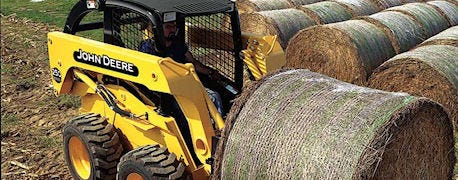March 8, 2012

Skid-steer operators often overestimate their safety inside their cabs and cages – particularly heavy-lifting grapple forks and big bale prongs. But that overconfidence may have cost four operators their lives in recent weeks.'
Since mid-February, fatalities have occurred with a skid-steer loaders on four farm in New York, Minnesota, Indiana and Wisconsin, says Dennis Murphy, ag safety expert at Penn State University. And, he notes that the accidents all had certain factors in common.'

SAFELY-DO-IT! Accidents with skid-steer loaders claimed lives on four farms in the last month by crushings and roll-overs. Moving while carrying heavy loads high invites disaster.
"One operator died after being crushed by the loader bucket, one was a rollover on uneven ground and the others appeared to be rollovers caused by loads carried too high." The major contributing factors were similar – carrying loads too high. And, he adds, "that danger can be mitigated by taking precautions."'
Murphy, who heads the Agricultural Safety and Health Program in the Department of Agricultural and Biological Engineering, reminds producers and employees that skid-steer operation demands attention to safety factors similar to those encountered when operating farm tractors with a front-end loader. He offers the following tips:'
Avoid moving with raised loads, which elevate the skid steer's center of gravity in relation to the stability baseline of the machine. It increases the danger of a rollover. "Carrying loads 'low and slow' keeps the center of gravity low, thus reducing the chance of rollover," he says.'
Maintain a clear view of the work area, nearby workers or bystanders, and other obstacles.'
Keep children away from the work area.'
Use the seatbelt during skid-steer operation. It'll keep the operator inside the "zone of protection" if an accident occurs.'
If the machine's bucket must be raised for any non-operation activity, use the boom lock to secure the bucket and lift arms and keep them from inadvertently falling.'
Train all family workers and newly hired employees to operate a skid-steer properly and safely, and provide an annual training review for experienced employees.'
"The usefulness of skid-steers for agricultural and landscape operations is hard to overstate, but they aren't without their limitations," he points out. "The skill and knowledge required for safe operation is often misunderstood and sometimes underestimated. We must end this string of tragic accidents involving their use."'
A free fact sheet on skid-steer safety is available online at http://www.agsafety.psu.edu/factsheets/E47.pdf. A downloadable PowerPoint presentation on skid-steer safety in Spanish is available at www.agsafety.psu.edu.'
You May Also Like




